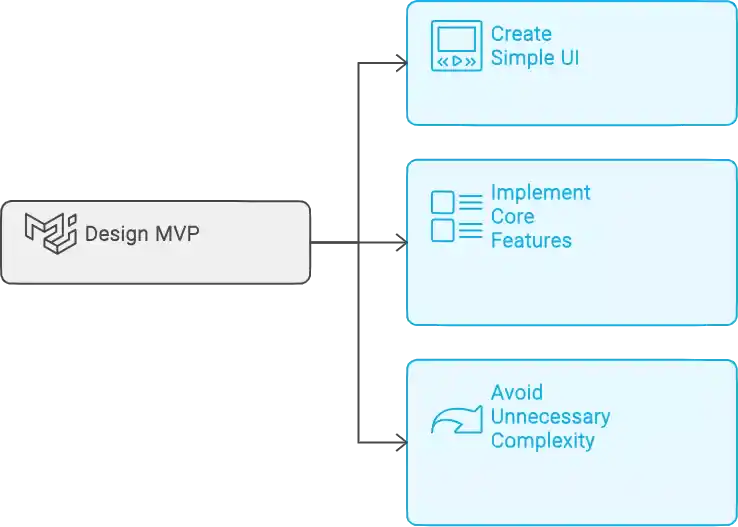Table of Contents
Building a Minimum Viable Product, or MVP might sound like something only big tech companies do, but it’s a powerful concept that anyone—even a 10th grader like you—can grasp and apply. This guide will walk you through the process of creating an MVP, using relatable examples and a conversational tone to make the information engaging and easy to understand.
By the end of this post, you’ll see why starting with an MVP can be a game-changer for bringing your ideas to life.
What is a Minimum Viable Product (MVP)?
Definition of an MVP
Imagine you have a brilliant idea for a new app or product, but you’re not sure if people will like it. Instead of spending months (or years) developing a fully-featured product, you create a simpler version with just enough features to test your idea. This initial version is called a Minimum Viable Product, or MVP.
It is a basic, functional version of your product that allows you to gather the maximum amount of validated learning about your customers with the least effort. Think of it as a rough draft that you share with your audience to see if they like the concept before you put in all the hard work to polish it up.
Purpose of an MVP: Attract Early Users, Gather Feedback, Validate Ideas
An MVP’s main goals are to attract early users, gather feedback, and validate your ideas. By launching an MVP, you can see how real users interact with your product and what they think about it. This feedback is invaluable because it helps you understand whether your idea has potential and what adjustments you need to make.
Identify Your Minimum Viable Product
Determine Your Product’s Core Features
Start by identifying the core features that your product must have to solve the problem you’re addressing. For example, if you’re creating a to-do list app, the core feature might be adding and checking off tasks. It’s tempting to include every cool idea you have, but the key to an MVP is restraint.
Focus on the Most Essential Functionality
Once you’ve identified the core features, focus on implementing them in the simplest way possible. Prioritize features based on user needs, not on what’s trendy or what you think might be nice to have. The goal is to create something that people can start using right away and find valuable.
Prioritize Features Based on User Needs
Consider the story of Dropbox. When they first started, instead of building a full-fledged product, they created a simple video demonstrating the basic functionality of their cloud storage service. This video helped them validate the demand for their product before investing time and resources into full development.
Design Your MVP

Create a Simple, User-Friendly Interface
It should be easy to use. Design a clean, intuitive interface that allows users to engage with the core features without any unnecessary distractions. Remember, simplicity is key.
Implement Core Features Only
Stick to the essentials. For instance, if you’re building a new social media platform, start with just the basic ability to create profiles and post updates. Leave advanced features like video streaming and complex algorithms for later.
Avoid Unnecessary Complexity
Avoid adding extra features that can complicate the user experience. Each feature should serve a clear purpose and add value to the core functionality of your product.
Develop Your MVP
Use Agile Development Methodologies
Adopt agile development practices to build it. Agile methodologies emphasize iterative development, where you continuously test and improve your product based on user feedback. This approach helps you stay flexible and responsive to users’ needs.
Leverage Existing Tools and Technologies
Don’t reinvent the wheel. Use existing tools and technologies to speed up development. For example, you can use website builders, app development frameworks, and other software tools that provide basic functionalities out of the box.
Streamline the Development Process
Keep the development process streamlined by focusing on the essential tasks. Set clear goals and deadlines, and avoid getting sidetracked by non-essential features or activities.
Test and Iterate
Release Your Product to Early Users
Once your product is ready, release it to a small group of early users. These could be friends, family, or a select group of target customers who can provide honest feedback.
Gather User Feedback and Data
Collect feedback and data on how users interact with your product. Pay attention to what they like, what they find confusing, and what features they wish your product had. This information is crucial for improving your product.
Refine Your Product Based on Insights
Use the insights gained from user feedback to make necessary adjustments and improvements. This iterative process helps you fine-tune your product to better meet user needs and preferences.
Benefits of Building an MVP

Validate Your Product Concept Efficiently
It allows you to test your product concept quickly and efficiently. By getting a basic version of your product into the hands of users, you can validate whether there is a real demand for it before investing too much time and money.
Reduce Development Time and Costs
Developing it helps you avoid the risk of spending resources on a product that might not succeed. By focusing on the core features and getting user feedback early, you can make informed decisions about the direction of your product.
Gain Valuable User Insights to Improve Your Product
The feedback and data you collect from your users provide invaluable insights into what works and what doesn’t. This information helps you make better decisions about future development and ensures that you build a product that truly meets the needs of your users.
Conclusion
The Importance of Starting with an MVP
Starting with an MVP is a smart strategy for any new product development. It helps you validate your ideas, save time and money, and gather essential user feedback. By focusing on the core features and iterating based on user insights, you can create a product that has a much higher chance of success.
Key Takeaways for Building a Successful MVP
- Focus on Core Features: Identify and prioritize the most essential functionalities.
- Keep It Simple: Design a user-friendly interface and avoid unnecessary complexity.
- Use Agile Methodologies: Develop iteratively and stay responsive to user feedback.
- Gather Feedback: Release your product to early users and refine based on their insights.